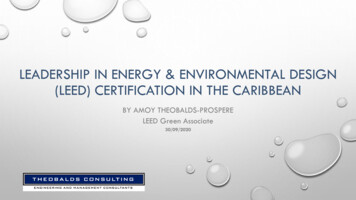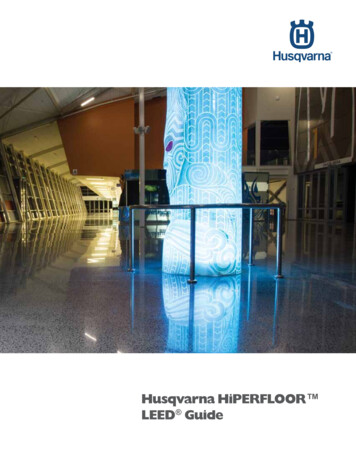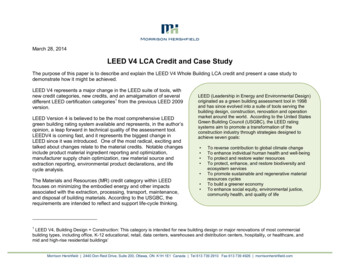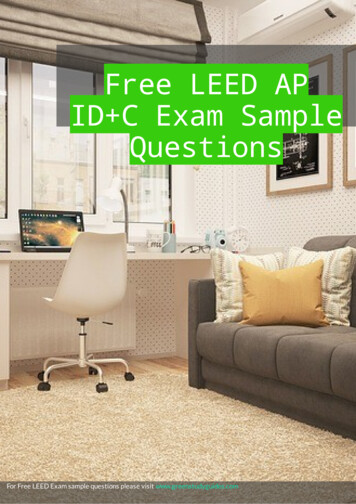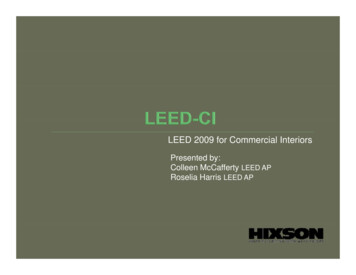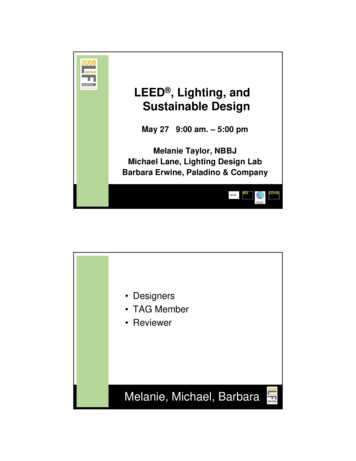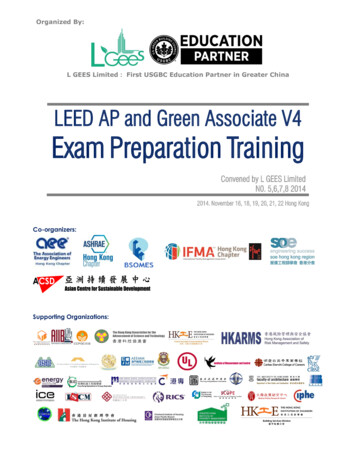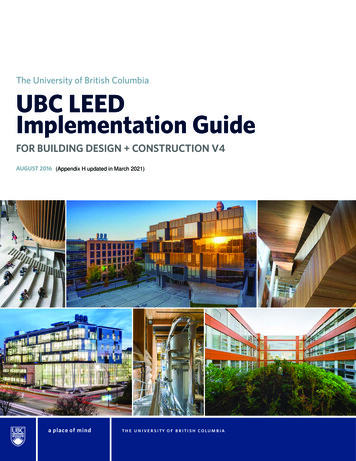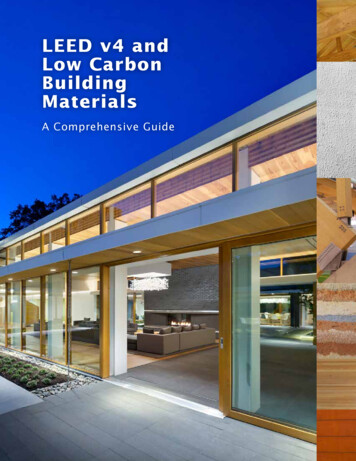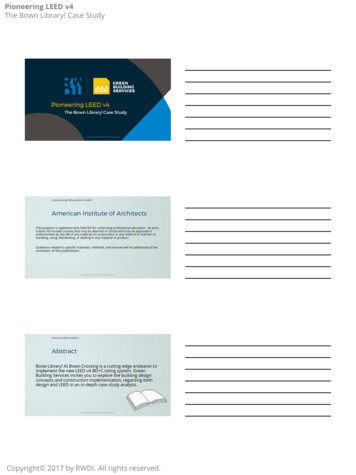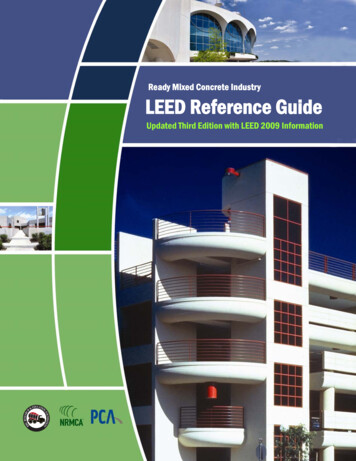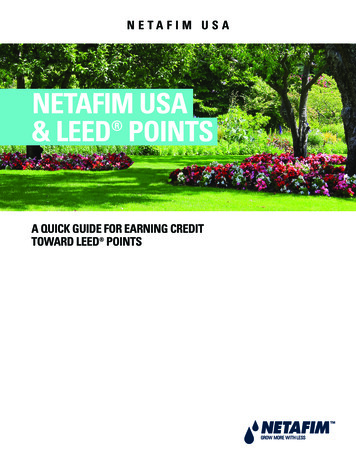
Transcription
NETAFIM USANETAFIM USA & LEED POINTSA QUICK GUIDE FOR EARNING CREDITTOWARD LEED POINTS
INTRODUCTIONWhat is LEED ?LEED, or Leadership in Energy and Environmental Design, is an internationally-recognized green building certificationsystem. Developed by the U.S. Green Building Council (USGBC) in March 2000, LEED provides building ownersand operators with a framework for identifying and implementing practical and measurable green building design,construction, operations and maintenance solutions.LEED promotes sustainable building and development practices through a suite of rating systems that recognizeprojects that implement strategies for better environmental and health performance.Netafim Sustainability CommitmentFor over four decades, in 110 countries, Netafim has helped people to grow more and better - with less. Striving to findsolutions that work with nature is at the core of what we do and who we are.But Netafim is much more than a prompt, efficient response to global crisis. From the start, we have known that it isup to all of us not only to sustain what exists but to create and ensure dependable supplies for tomorrow, and the dayafter. To that end we have focused on three key areas: environmental sustainability, social responsibility and corporategovernance.With over 100 million pounds of plastics being used in Agricultural applications, Netafim has commitment to a program(http://www.nteafimrecycling.com/) that collects used tubing and produces recycled resin that is reused in landscapedrip tubing applications.The following will help guide you through the qualifications to earn credit toward LEED points.LEED Rating System ProductsLEED covers many different types of buildings and construction under the following LEED products: LEED for New Construction and Major Renovations (“LEED-NC”) LEED for Existing Buildings (“LEED-EB”) LEED for Commercial Interiors (“LEED-CI”) LEED for Core and Shell (“LEED-CS”) LEED for Schools LEED for Homes LEED for Retail LEED for Healthcare Under development: LEED for NeighborhoodsNOTE:This guide provides general information on the LEED Green Building Rating System.It is not intended to provide professional design, legal or construction managementadvice and should not be relied on for those purposes. Such advice may only beprovided by licensed professionals in the jurisdiction applicable to the constructionproject. LEED is a registered trademark of the USGBC.2NETAFIM USA LEED GUIDE
INTRODUCTIONPoints for Certification for LEED 2009 New ConstructionThe LEED rating system addressed in this document is the LEED for New Construction and Major Renovations. Thereare seven topics which are broken down into individual LEED Credit points. A certain number of points must beachieved to obtain certification. The categories and the number of points available are as follows:A building requires at least 40 points to achieve certification.The levels of certification are: Certified (40 - 49 points) Silver (50 - 59 points) Gold (60 - 79 points) Platinum (80 points)Detailed information on obtaining credits and the projectcertification process is available from the USGBC on theirLEED website: www.usgbc.org. The website outlines theintent, requirements, and strategies for meeting each credit.NEW CONSTRUCTION RATING SYSTEMCATEGORYSustainable Sites (SS)Water Efficiency (WE)Energy and Atmosphere (EA)Materials and Resources (MR)Indoor Environmental Quality (IEQ)Innovation and Design Process (ID)Regional Priority (RP)TOTAL POINTSPOINTS261035141564110Netafim USA and LEED for New ConstructionNetafim USA supports the strategies of LEED to achieving a prosperous and sustainable future through cost-efficientand energy-saving green buildings. The LEED system does not certify individual products, however, the combination ofproducts contribute to the overall building project’s earning of LEED credits. Netafim USA’s products can contribute tothe following credits in the LEED for New Construction system: Water Efficiency Credit 1.1: Reduce Irrigation need by 50% (2 points) Water Efficiency Credit 1.2: No Potable Water Use or No Irrigation (2 points) Materials and Resources Credit 4.1 and 4.2: Recycled Content (1-2 point)Other areas where Netafim drip irrigation products and/or landscape design strategies can contribute to LEED creditsare as follows: Sustainable Sites Credit 5.1: Site Development: Protect or Restore Habitat (1 point) Sustainable Sites Credit 6.1: Stormwater Design: Quantity Control 1 point) Sustainable Sites Credit 7.2: Heat Island Effect (1 point) Energy and Atmosphere Credit 1: Optimize Energy Performance (1-19 points) Innovation in Design Credit 1: Innovation in Design (5 points) Innovation in Design Credit 2: LEED Accredited Professional (1 point) Regional Points Credit 1 (4 points)NOTE: LEED Credit Points are awarded to certifying the design and construction of commercial or institutionalbuildings and high-rise residential buildings of all sizes, both public and private. LEED Credit Points are not awarded toindividual components or products. The components or products help in achieving points for the building, but are notrated by themselves.NETAFIM USA LEED GUIDE3
LEED CREDITSWATER EFFICIENCY CREDIT 1.1WATER EFFICIENT LANDSCAPING (OPTION 1)REDUCE BY 50% (2 POINTS)IntentTo limit or eliminate the use of potable water, or other natural surface or subsurface water resources available on ornear the project site for landscape irrigation.RequirementsReduce potable water consumption for irrigation by 50% from a calculated mid-summer baseline case. Reductionsshall be attributed to any combination of the following items: Plant species factor Irrigation efficiency Use of captured rainwater Use of recycled wastewater Use of water treated and conveyed by a public agency specifically for non-potable usesPotential Technologies and StrategiesPerform a soil/climate analysis to determine appropriate plant material and design the landscape with native oradapted plants to reduce or eliminate irrigation requirements. Where irrigation is required, use high-efficiencyequipment and/or climate-based controllers.CalculationsTo calculate the percent reduction in potable use for this credit, establish a baseline water use rate for your project,which represents a “typical” landscape that could be found on a similar project in the area. Then, calculate theas-designed water use rate for the project. To complete these calculations, you will need to know the landscapecoefficients for the major vegetation types, and the area of each.All calculations must be based on irrigation during the month with the highest evapotranspiration (ET) rate. Local ETovalues are available from the EPA’s WaterSense website.You will also need to document the Irrigation Efficiency (IE) for each landscape area, based on the type of irrigationused. Standard numbers for Sprinkler and Drip are given in the LEED reference guide, and should be used to calculatethe baseline case water use.Irrigation Efficiency for the Design case may use different numbers than in the Baseline case based on the efficiencynumbers of the products selected for the irrigation plan.Controller Efficiency (CE) is another number that may have to be determined, and is defined as the percent reduction inwater use from any weather-based controllers or moisture sensor-based systems. It is equal to 1 minus the estimatedpercentage of overall irrigation water saved by the controller (CE 1 - % Savings).4NETAFIM USA LEED GUIDE
LEED CREDITSCalculations (Continued)If applicable, the volume of reuse water (captured rainwater, recycled graywater, or treated wastewater) available inthe month with the highest irrigation demand can be added into the savings of potable water.Once the water savings based on vegetation types, irrigation efficiency, controller efficiency, and reuse water arecalculated; the total percentage reduction of potable water use must be equal to or greater than 50% to earn WECredit 1, Option 1. The Reference Guide, and the USGBC website contain detailed explanations, examples, worksheets,and forms required to complete the calculations for all LEED Credits.The table below lists the Netafim products that a designer can use to help achieve the required 50% reduction to earnthe points for this Credit Option.NETAFIM PRODUCTS FOR 50% REDUCTIONCATEGORYLandscape Drip TubingMODELSTechline CVTechlineTechline RWTechline EZPolyethylene (PE)Landscape Drip Tubingwith Check ValveTechline CVLandscape Drip ControlZone KitsLow VolumeControlZone KitsPressure RegulatorsPRV SeriesWATER SAVINGS40%REFERENCEAverage water savings confirmed by Bilderback,T.E. and M.A. Powell. Efficient irrigation.North Carolina Extension Service, PublicationNumber AG-508-6, March 1996. 21 January 20055 %Any amount of slope to the piping system can leadto water draining out the lowest point of thesystem. In sprinklers, check valves save waterby holding the water in the piping system whenthe irrigation system is not operating. Potentialsavings depends on the amount of piping in theground, and slope in the sprinkler zone.5 %Every 5 psi reduction in pressure reduces waterusage by 6-8%. A 70 psi system reduced to arecommend 30 psi can provide more than 50%in water savings. Derived from Bermouli’s equation(5.19). Refer to Roberson/Crowe,Engineering FluidMechanics (fourth Edition), Houghton Mifflin Co.Boston, MA 1990.NETAFIM USA LEED GUIDE5
LEED CREDITSWATER EFFICIENCY CREDIT 1.2WATER EFFICIENT LANDSCAPING (OPTION 2)NO POTABLE WATER USE OR NO IRRIGATION (2 POINTS)IntentTo limit or eliminate the use of potable water, or other natural surface or subsurface water resources available on ornear the project site for landscape irrigation.RequirementsAchieve WE Credit 1.1.and:Use only captured rainwater, recycled wastewater, recycled graywater, or water treated and conveyed by a publicagency specifically for non-potable uses for irrigation.-ORInstall landscaping that does not require permanent irrigation systems. Temporary irrigation systems used for plantestablishment are allowed only if removed within one year of installation.If the Percent Reduction of Potable Water is 100% AND the Percent Reduction of Total Water is equal to or greater than 50%,WE Credit 1.2 is earned in addition to WE Credit 1.1.Potential Technologies and StrategiesPerform a soil/climate analysis to determine appropriate landscape types and design the landscape with indigenousplants to reduce or eliminate irrigation requirements. Consider using stormwater, graywater, and/or condensate waterfor irrigation.The table below lists the Netafim products are designed for operation in non-potable systems and help achieve thiscredit.NETAFIM PRODUCTS FOR NON-POTABLE SYSTEMSCATEGORYLandscape Drip Tubing6MODELSTechline CVTechlineTechline RWUse for temporary irrigationTechline EZPolyethylene (PE)Landscape Drip TubingTechline RWWastewater Drip TubingBiolineNETAFIM USA LEED GUIDECREDITPurple stripe on brown tubing fornon-potable applicationsPurple tubing for wastewaterapplications
LEED CREDITSMATERIAL AND RESOURCES CREDIT 4RECYCLED CONTENT (1 - 2 POINTS)IntentTo increase demand for building products that incorporate recycled content materials, thereby reducing impactsresulting from extraction and processing of virgin materials.RequirementsOne point is awarded if the sum of the postconsumer recycled content plus one-half of thepre-consumer recycled content constitutes atleast 10% of the total value of the materials in theproject. MR Credit 4.2 is similar but requires atotal of 20%, based on cost.NETAFIM PRODUCTS WITH RECYCLED CONTENTCATEGORYLandscape Drip TubingMODELSRECYCLED CONTENTTechline CVTechlineTechline RWTechline EZPolyethylene (PE)20%The recycled content value of a material assemblyis determined by weight. The recycled fraction ofthe assembly is then multiplied by the cost of assembly to determine the recycled content value.The table above lists the Netafim products with the required pre-consumer and post consumer recycled content andhelp achieve this credit.OTHER LEED CREDITSSustainable Sites Credits 5.1: Site Development: Protect or Restore Habitat (1 point)An efficient irrigation system is important to supporting landscape designs that conserve existing natural areas andrestore native plant or adapted plants. Point source drip irrigation is ideal for shrubs and native plants with wide and/or random spacing requirements and inhibits weed growth in the areas with no plants.Sustainable Sites Credit 6.1: Stormwater Design: Quantity Control (1 point)Limiting disruption of natural water hydrology by reducing impervious cover, increasing on-site infiltration, reducing oreliminating pollution from stormwater runoff, and eliminating contaminants can earn points for Sustainable Sites Credit6.1: Stormwater Design: Quantity Control. Irrigation can be used to eliminate stormwater run-off by using all capturedrainwater and run-off for irrigating the landscape.Sustainable Sites Credit 7.2: Heat Island Effect (1 point)Installing a vegetated roof that covers at least 50% of the roof area is one option to earn credit for this category.Dripline irrigation is ideal for watering roof top vegetation since wind speeds on top of roofs can be considerablyhigher than they are at ground level. In some instances, gusts can reach 80 miles per hours, even when weatherconditions on the ground are calm. These windy conditions could cause the water from the sprinklers to be blownaway and land in another location. With a dripline irrigation system, water drips directly on to the roof garden’s plants,eliminating the fears of inadvertent spraying.NETAFIM USA LEED GUIDE7
LEED CREDITSOTHER LEED CREDITSMaterials and Resources Credit 5 - Regional Materials (1-2 points)Using building materials and products that are extracted, harvested or recovered, as well as manufactured withinthe region, supports the use of indigenous resources and reduces the environmental impacts resulting fromtransportation. While Netafim USA Techline tubing is manufactured in Fresno, California, the resin and raw materialsused are not extracted locally and therefore does not qualify for this credit.Energy and Atmosphere Credit 1: Optimize Energy Performance (1-19 points)The intent of this Credit is to achieve increasing levels of energy performance above a baseline standard, to reduceenvironmental and economic impacts associated with excessive energy use. Appropriate landscape design canaid in the sheltering of buildings from winter winds, and also shading from the summer sun. These strategies canhelp to reduce the heating and cooling loads, saving energy, and the impacts that energy generation can have. Thesurrounding landscape of the building can also have an effect on the ambient temperature near buildings, effectingenergy usage. Green walls and mature trees to shade the building, and appropriate turf areas to cool the immediatearea around structures, can be helpful to meet the requirements. Efficient irrigation can be important in supporting theplant material for optimum benefit.Innovation in Design Credit 1: Innovation in Design/Exceptional Performance (5 points)Providing design teams and projects the opportunity to achieve exceptional performance above the requirements setby the LEED Green Building Rating System and/or innovative performance in Green Building categories not specificallyaddressed by the system. Applying irrigation strategies or measures that demonstrate a comprehensive approach andquantifiable environmental and/or health benefits can be considered for points in this category.Innovation in Design Credit 2: LEED Accredited Professional (1 point)One point is given if a principal participant of the project team is a LEED Accredited Professional. The irrigationindustry has LEED-experienced professionals available to help maximize the points for efficient irrigation andlandscaping.Regional Points Credit (RP Credit 1) (4 points)Earn one of the six Regional Priority credits – to a maximum of 4 credits per project (credits identified as havingadditional regional environmental importance by the USGBC Regional Councils and Chapters for the project’s location).A database of Regional Priority credits and their geographic applicability is available as they are released on theUSGBC website – www.usgbc.org. One point is awarded for each Regional Priority credit earned. No more than 4Regional Priority credits may be earned. Non-U.S. projects are not eligible for Regional Priority credits.NETAFIM USA5470 E. Home Ave.Fresno, CA 93727CS 888 638 2346www.netafimusa.com05/16
This guide provides general information on the LEED Green Building Rating System. It is not intended to provide professional design, legal or construction management advice and should not be relied on for those purposes. Such advice may only be provided by licensed professionals in the jurisdiction
